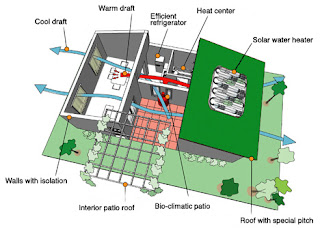by Krista Peterson
While it may initially seem like the only benefits of “green building” efforts go to the environment – at the cost of human comfort and expense – this is not the case. Proponents of eco-friendly architecture take a holistic approach to the concept of environmental health, including human well-being in their calculations. The U.S. Environmental Protection Agency lists three goals of green building programs: to increase efficiency in the use of water, energy, etc.; to protect the health and increase the productivity of the building’s residents; and to reduce pollution and waste.
Greater Efficiency
According to the EPA, in 2002, buildings accounted for 67.9% of the total electricity consumption in the United States. It has been said many times already, but decreasing energy use is not only good for the environment – it’s good for the wallet. When a building is more energy efficient, less HVAC (heating, ventilation, air conditioning) equipment is necessary. Since heating and cooling the air accounts for roughly half of a building’s energy expenditure, improving efficiency can significantly reduce operating costs. Other small measures, such as upgrading insulation and sealing any air leaks, can make a big difference in a monthly electricity bill.
 |
| :: image via Treehugger |
The high costs commonly associated with going green are usually a result of installing new technology in a new building or retrofitting an older one. On-site renewable energy generators from sources such as photovoltaic solar panels or wind power can include prohibitive start-up costs and may not be feasible for every structure. However, efficient appliances with the Energy Star label often cost the same as traditional appliances, and installing ceiling fans to reduce the need for air conditioning is a simple step that makes a measurable difference. For new buildings, passive solar heating principles that take advantage of the orientation of the sun and the landscape go a long way toward improving energy efficiency.
Better Health
Another goal of green building is to improve air and water quality within structures, as well as the productivity of their occupants. One EPA report states that indoor air pollutant levels are about two to five times higher than those of outdoor air. Some of these pollutants, such as radon gas, are attributable to natural conditions, while others such as second-hand smoke are a direct result of human behavior. However, many of these pollutants are a byproduct of the materials used to construct or furnish the building. Volatile organic compounds, or VOCs, can cause serious health consequences in large enough concentrations. These chemicals may occur naturally, but they can also be manmade, and are found most commonly indoors in products such as paints, solvents, carpets, cleaning products, and some household appliances.
 |
| :: image via Sun Sentinel |
Asbestos is another dangerous pollutant. While this thread-like mineral is no longer used in the manufacture of new building materials, it was widely used in nearly every aspect of construction until the 1980s and can still be found in most of these buildings. When breathed in or ingested, asbestos fibers can cause serious health problems such as lung scarring, asbestosis, and mesothelioma cancer. Mesothelioma symptoms include shortness of breath, coughing, and pain in the chest, very similar to other, less fatal lung conditions, which can mean that the cancer often goes undiagnosed until its later stages. Green building efforts take into account the human costs of building with certain materials – though asbestos makes for an effective source of insulation, it is severely dangerous to a structure’s occupants, and thus alternative materials are used instead.
Less Waste
One simple way that green architecture produces less waste is by using renewable materials, such as plant matter and sustainable lumber, or reusing traditional materials, such as recycled stone or metal. It is even possible to reuse industrial byproducts like coal combustion products, foundry sand, and demolition debris. Ecologically responsible construction can also help the occupants of the building waste fewer resources when going about their daily lives – greywater can be used as irrigation, or treated and used for other non-drinkable purposes.
 |
| :: image via Eco-trees |
Moreover, green building furthers the concept of “smart growth,” an umbrella term for architecture and urban planning that takes into account sustainability, human health and safety, and economic expansion. It is not enough to simply substitute one building material for another; an entire change of outlook is necessary if we want to be able to sustain our quality of life, and green building is one way to start. The benefits are highly visible – mesothelioma symptoms, for example, can be prevented almost entirely by avoiding exposure to asbestos. Looking beyond individual health, the EPA estimates that buildings contribute 38.1% of the country’s carbon dioxide emissions, but this figure can be reduced through the use of environmentally responsible architecture and urban planning.
I want to know about some important concepts like designing villas, houses, towers, commercial buildings. Please provide any best site from where I can get information about green building. Thanks.